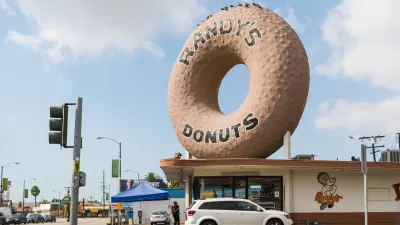A mixed-use development proposal in South L.A. highlights a blind spot of progressive urbanism—the gap between what checks all the boxes and what low-income communities really need.

The development known as The Reef is all about "placemaking." Located next to a Metro rail station, it aims to increase density as well as housing supply, attract investors to South Los Angeles, and create jobs through a local-hire agreement.
In addition to your typical mixed-use fare—residential, hotel, retail, and restaurant—the billion-dollar project will ultimately include amenities designed to meet specific community needs: a grocery store, a pharmacy, a bank, investment in a new DASH route (the hyper-local bus service run by LADOT).
But what residents want is much more basic: not to have to leave once the project moves in.
In an important analysis in Streetsblog LA, Sahra Sulaiman writes:
To an urbanist or a livability advocate, [The Reef's] approach might sound like it hits all the right notes … But to a lower-income black or Latino resident of Historic South Central – a historically disadvantaged community with the distinction of having the most overcrowded housing in the country – that approach and its potential ripple effects present a much more complicated and far less rosy picture.
Plans presented at public meetings "pitted members of the community against each other by seemingly asking them to make the impossible choice between jobs and housing," she explains. The promise of mostly temporary jobs belied the certainty of long-term increases in rents and the cost of living—leading to likely permanent displacement.
Community activists like the UNIDAD coalition (which went up against Geoff Palmer’s Lorenzo project in 2011) want The Reef to skip the fitness center and tackle those consequences head on. Their community benefits proposal asks developers to help secure eviction protections, an emergency rental aid fund, and other anti-displacement tools for residential and commercial tenants, as well as safety solutions that won’t further criminalize youth of color and the homeless.
These demands, Sulaiman writes, reflect "an understanding of how a history of discriminatory planning policies, disinvestment, and disenfranchisement created the very conditions that make the community so favorable to developers today."
But as she also notes, developers are only one piece of the puzzle. The difference between what they can or are willing to offer, and what residents want and need, "highlight[s] how few tools we actually have at our disposal to ensure our communities become more inclusive as they grow."

Alabama: Trump Terminates Settlements for Black Communities Harmed By Raw Sewage
Trump deemed the landmark civil rights agreement “illegal DEI and environmental justice policy.”

Planetizen Federal Action Tracker
A weekly monitor of how Trump’s orders and actions are impacting planners and planning in America.

The 120 Year Old Tiny Home Villages That Sheltered San Francisco’s Earthquake Refugees
More than a century ago, San Francisco mobilized to house thousands of residents displaced by the 1906 earthquake. Could their strategy offer a model for the present?

Ken Jennings Launches Transit Web Series
The Jeopardy champ wants you to ride public transit.

BLM To Rescind Public Lands Rule
The change will downgrade conservation, once again putting federal land at risk for mining and other extractive uses.

Indy Neighborhood Group Builds Temporary Multi-Use Path
Community members, aided in part by funding from the city, repurposed a vehicle lane to create a protected bike and pedestrian path for the summer season.
Urban Design for Planners 1: Software Tools
This six-course series explores essential urban design concepts using open source software and equips planners with the tools they need to participate fully in the urban design process.
Planning for Universal Design
Learn the tools for implementing Universal Design in planning regulations.
Clanton & Associates, Inc.
Jessamine County Fiscal Court
Institute for Housing and Urban Development Studies (IHS)
City of Grandview
Harvard GSD Executive Education
Toledo-Lucas County Plan Commissions
Salt Lake City
NYU Wagner Graduate School of Public Service





























